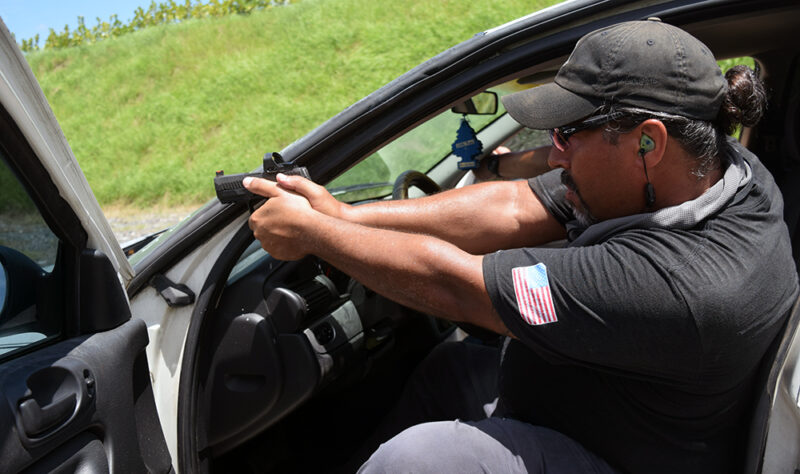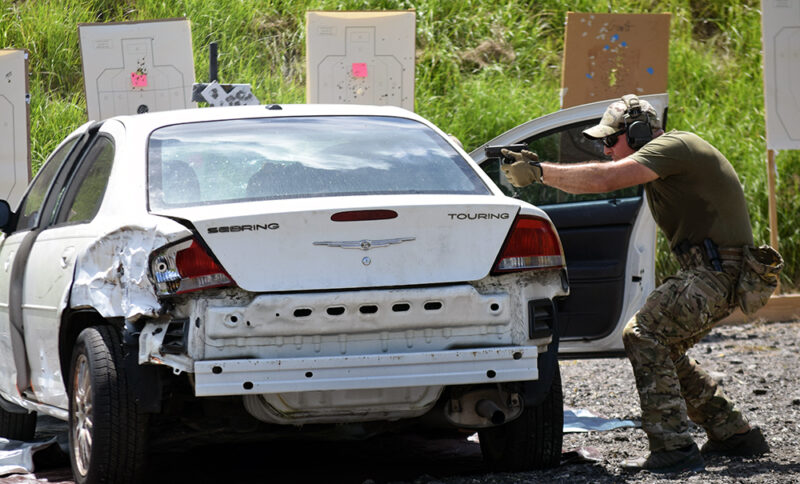Advanced Gun Training; a Lifestyle Choice for Shooters
By Andre’ M. Dall’au

The ability to competently use a firearm is skill-based. While being a natural shot is possible, there’s no such thing as a natural shooter. The ability to understand firearm safety, the fundamentals of marksmanship and knowing both the technical aspects of firearms and ammunition is learned knowledge. This includes learning the law.
A lot of people think that firearms instruction is mostly for beginners. However, experienced shooters benefit greatly from advanced gun training as a lifestyle. It is smart to regularly attend training classes to both strengthen and expand skills.
Why Advanced Gun Training
The only way to obtain skill is through proper instruction followed by repetitions. This instills correct muscle memory, which will be unconsciously used when under stress. The best way to get that life-saving muscle memory is through advanced gun training by a qualified and experienced teacher.
Being a terrific competition shooter or an incredible operator doesn’t mean a person can pass on complex and dynamic concepts and skills. Teaching requires someone who has the unique skillset of being an excellent shooter but it also requires the ability to provide students with effective drills, practice and confidence to be competent, safe and accurate shooters.
Luckily, there are numerous training organizations, such as Gunsite, GLOCK Training and SIG SAUER Academy. There are also excellent trainers, including Marty Castellanos, Kris “Tanto” Paranto and Dave “Boon” Benton. Each one offers a mix of classes from new, first-time shooters to experienced operators and LE professionals.
Experience Counts
Dave “Boon” Benton is a trained and qualified firearms and tactical trainer who teaches a lot of the skills he used during the events of Benghazi in 2012. That’s when he, Kris “Tanto” Paranto and a team of operators successfully fought off determined assaults of terrorists trying to overrun a Libyan CIA Annex.
First, the attackers successfully conquered the Ambassador’s compound that ended with the death of the American Ambassador J. Christopher Stevens and Communications Specialist Sean Smith. After being initially delayed, Boon, Tanto and the Annex operators rescued five State Department agents and fought their way back to their compound. There, they spent the night fighting off a series of determined assaults. The successful defense resulted in the deaths of Tyrone Woods and Glen Doherty but saved the rest of the American personnel besieged in the Annex. The events of that powerful series of firefights were retold in the book and later movie “13 Hours” where Boon was (accurately) portrayed by the actor David Denman.
Boon was a Scout Sniper on a Maritime Special Purpose Force tasked with direct-action assaults and hostage rescue. He also served as a Marine Corps-trained instructor. After that, Boon served as a SWAT team member, then post-9/11, as a Global Response Staff contract operator for the State Department. He served in hotspots all over the world and led to him being part of the GRS team in Libya.
Best Instructors Give Best Classes
“I look at training for shooters less in what classes to take, but in phases as each shooter progresses through,” said Boon. “There’s the marksmanship, weapons handling fundamentals phase that a shooter uses as a skill-based foundation that validates the shooter’s qualification and ability to move forward to more complex training requiring movement and multiple targets. Then there’s the next phase (where you turn training into muscle memory) with supervised range drills during courses like vehicle defense class (learning to fight inside and out of vehicles,) low-light and tactical carbine or pistol classes. The last phase would be the introduction of stress management by the use of active role-players for force-on-force training with impact and marking munitions.”
He mentioned that classes in each of the phases should be taken as much as possible dependent on individual needs. After every training session, students should leave with information on how they can improve identified issues needing refinement. That feedback also assists in providing students with a training plan for future classes.
Advanced Gun Training at Home
I asked Boon about how even the most experienced shooters can maintain proficiency. Just like every other professional trainer, shooter or competitor, he said that home dry-fire practice is absolutely essential.
“While the military can spend weeks to provide a satisfactory level of training, civilian shooters rarely can get that immersion, so work on their own is essential,” said Boon. “That means that dry fire exactly as was trained, prevents the student from losing the learning momentum that the course provided.”
He also discussed technology-based dry fire aids like the Mantis System. These systems provide information about accuracy and point-of-aim drift on a computer or phone.
“I think that is invaluable for helping a shooter verify their trigger pull, grip pressure and is huge for displaying the diagnostics needed for accurate delivery of rounds on target.”
Personal Experience

I have taken several of Boon’s advanced gun training classes from pistol, carbine and even vehicle situations, where students learn how to defend and fight in and around a car. While many of the basic fundamentals are unchanged, responding to threats from the inside of a vehicle does present problems that are best solved beforehand. This includes how bullets respond to hitting parts of the car, such as glass when shooting from the inside out, and outside in.
We all took turns using our preferred defensive load and I was pleased to find my Glock G45 using Black Hills 9mm HoneyBadger with its aggressive Lehigh Xtreme Defense 125-grain bullet pierced bodywork well. It also had minimal deflection when shot through the windshield.
I even worked with him on a low-light class, learning the difficult techniques of shooting using both hand-held and pistol-mounted lights. Part of both the vehicle defense class and low-light defensive class involved the use of force-on-force role-players with Simunition or UTM marking rounds to better gauge the effectiveness of the shooter’s ability during induced stress. This is an essential part of real-world defensive situations.
Boon, Tanto, Marty and many other tactical and firearms instructors provide incredible instruction. This includes how to keep improving advanced gun training at home and maximize practice at the range.







